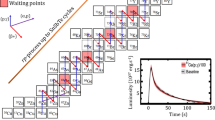Abstract.
The Canadian Penning trap (CPT) mass spectrometer at the Argonne National Laboratory makes precise mass measurements of nuclides with short half-lives. Since the previous ENAM conference, many significant modifications to the apparatus were implemented to improve both the precision and efficiency of measurement, and now more than 60 radioactive isotopes have been measured with half-lives as short as one second and with a precision ( Δm/m) approaching 10-8. The CPT mass measurement program has concentrated so far on nuclides of importance to astrophysics. In particular, measurements have been obtained of isotopes along the rp-process path, in which energy is released from a series of rapid proton-capture reactions. An X-ray burst is one possible site for the rp-process mechanism which involves the accretion of hydrogen and helium from one star onto the surface of its neutron star binary companion. Mass measurements are required as key inputs to network calculations used to describe the rp-process in terms of the abundances of the nuclides produced, the light-curve profile of the X-ray bursts, and the energy produced. This paper will present the precise mass measurements made along the rp-process path with particular emphasis on the “waiting-point” nuclides 68Se and 64Ge.
Similar content being viewed by others
References
J.A. Clark, in Exotic Nuclei and Atomic Masses (ENAM2001), Hämeenlinna, Finland, 2001, edited by J. Äystö, P. Dendooven, A. Jokinen, M. Leino (Springer, Berlin, 2003) p. 39.
J.A. Clark, Phys. Rev. Lett. 92, 192501 (2004).
G. Savard, Phys. Rev. C 70, 042501 (2004).
J.A. Clark, in The r-Process: The Astrophysical Origin of the Heavy Elements and Related Rare Isotope Accelerator Physics, Seattle, Washington, 2004, edited by Y.-Z. Qian, E. Rehm, H. Schatz, F.-K. Thielemann (World Scientific, Singapore, 2004) p. 11.
K.S. Sharma, these proceedings.
R.K. Wallace, S.E. Woosley, Astrophys. J. Suppl. Ser. 45, 389 (1981).
H. Schatz, Phys. Rep. 294, 167 (1998).
M. Wiescher, J. Phys. G 25, R133 (1999).
T. Strohmayer, L. Bildsten, in Compact Stellar X-Ray Sources, edited by W.H.G. Lewin, M. van der Klis (Cambridge University Press, Cambridge) in press.
G. Savard, Nucl. Phys. A 626, 353 (1997).
J. Clark, Nucl. Instrum. Methods Phys. Res. B 204, 487 (2003).
G. Savard, Nucl. Instrum. Methods Phys. Res. B 204, 582 (2003).
C. Boudreau, Master’s thesis, McGill University, 2001.
G. Savard, Phys. Lett. A 158, 247 (1991).
L.S. Brown, G. Gabrielse, Rev. Mod. Phys. 58, 233 (1986).
G. Bollen, J. Appl. Phys. 68, 4355 (1990).
M. König, Int. J. Mass Spectrom. Ion Processes 142, 95 (1995).
G. Bollen, Nucl. Phys. A 693, 3 (2001).
G. Gräff, Z. Phys. A 297, 35 (1980).
G.F. Lima, Phys. Rev. C 65, 044618 (2002).
M. Chartier, private communication.
A. Wöhr, Nucl. Phys. A 742, 349 (2004).
G. Audi, Nucl. Phys. A 729, 337 (2003).
B.A. Brown, Phys. Rev. C 65, 045802 (2002).
R. Pfaff, Phys. Rev. C 53, 1753 (1996).
J.A. Clark, in preparation.
H. Schatz, Phys. Rev. Lett. 86, 3471 (2001).
D.D. Clayton, F. Hoyle, Astrophys. J. 187, L101 (1974).
J. Jos\’ e, Astrophys. J. 520, 347 (1999).
J.C. Hardy, Phys. Rev. C 9, 252 (1974).
J.A. Nolen, Nucl. Instrum. Methods 115, 189 (1974).
S. Bishop, Phys. Rev. Lett. 90, 162501 (2003).
G. Audi, A.H. Wapstra, Nucl. Phys. A 595, 409 (1995).
J.C. Hardy, Phys. Rev. Lett. 91, 082501 (2003).
M. Mukherjee, Phys. Rev. Lett. 93, 150801 (2004).
D. Seweryniak, Phys. Rev. Lett. 94, 032501 (2005).
Author information
Authors and Affiliations
Corresponding author
Rights and permissions
About this article
Cite this article
Clark, J.A., Barber, R.C., Blank, B. et al. Investigating the rp-process with the Canadian Penning trap mass spectrometer. Eur. Phys. J. A 25 (Suppl 1), 629–632 (2005). https://doi.org/10.1140/epjad/i2005-06-172-3
Received:
Accepted:
Published:
Issue Date:
DOI: https://doi.org/10.1140/epjad/i2005-06-172-3



